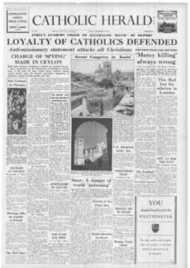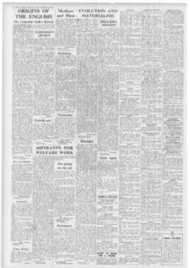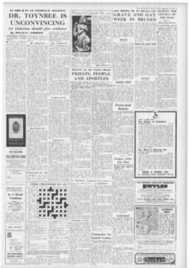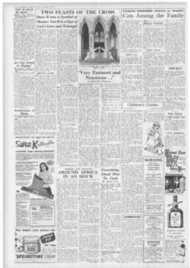Page 4, 14th September 1956
Page 4

Report an error
Noticed an error on this page?If you've noticed an error in this article please click here to report it.
Tags
Share
Related articles
Fr Clifford Howell Liturgy Reformer Loyal To The Church
`i Don't Hold With So-called Sacred Or Flowery Language'
English In The Mass
Liturgy Reforms
Holy Week And Easter
GREATEST CONFERENCE ON THE LITURGY
Fr. CLIFFORD HOWELL, S.J. tells what will happen next week at assembly in Assisi AS a generalisation it would be true to say that during the first thousand years of the Church's history the liturgy
was gradually taking shape through local initiative, and thus it assumed different forms in the various countries which became Christian.
There was, of course, a liturgy of Rome, but it was not imposed
on other places. However, it did spread to some extent, for it was brought to England by St. Augustine. Later it penetrated also into the Franco-Germanic empire under Charlemagne, there coming in contact with the ancient
Gallican liturgy. The result wag a fusion of the two forms which, during the course of the 11th century, spread over the Alps even into Rome itself.
This Gallico-Roman liturgy (henceforth regarded as authentically Roman because its mixed origin was not realised) gradually gained the ascendancy over all others during the next four centuries; a certain degree of uniformity thus came to prevail throughout the West and rendered it possible for Pope Pius
V, in 1570, to promulgate uniform liturgical books to be adopted officially.
A REVELATION
THERE had been liturgical reforms before the days of Pope Pius V, but this was the first large-scale reform to have really widespread effects.
It produced almost complete uniformity but also absolutely complete fixity, for the Sacred Congregation of Rites was set up in 1588 to give authoritative interpretations of liturgical laws and rubrics to the entire Roman patriarchate.
The liturgy thus became a collection of immutable formulae and ceremonies to be performed with the utmost exactness by the clergy; the ever changing circumstances and outlook of the laity had no more effect on it than it had upon them. For they had no function in it except that of being present at its performance. Their piety found expression in totally different channels.
About a century ago this prevailing rubrical attitude towards the liturgy became modified by the influence of Dom Prosper Gueranger, 0.S.B., who made what amounted to a startling discovery for those days-namely, that the liturgy was of its nature both beautiful and interesting.
There arose a " liturgical movement" concerned primarily to make known and appreciated the treasures of beauty and devotion enshrined in the Church's official forms of worship-it was a movement predominantly aesthetic and archeological.
At the beginning of the present century there came a revelation which was even more startling at the time-the recognition that the liturgy of its nature was not merely beautiful but also pastoral. It should concern not merely the clergy but also the laity, who should have a function in it.
This revelation was made by Pope St Pius X in his Motu Proprio of 1903, which stated that "the primary and indispensable source of the true Christian spirit is active participation in the sacred mysteries." And he made the pastoral aspect of liturgy even rnore clear by following up with his Decree on Frequent Communion.
THE PEOPLE
THUS us there arose a new kind
of liturgical movement, spearheaded by another great Benedictine, Dorn Lambert I3eauduin. This was primarily pastoral, concerned above all things to bring the people into the liturgy as participants.
The ideal spread through Belgium, France, Germany, Austria and Holland and inspired many outstanding workers. For many years their efforts were directed to making better use of the existing liturgy, using precisely what had been handed down, but in new and more effective ways. It was the epoch of the congregationally sung Mass and the Dialogue Mass.
But as time went on it became increasingly clear that there were enormous difficulties to be surmounted and that many of them were inherent in the present liturgical forms. As these had come into being without any regard for the functioning of the people they were in certain respects ill suited to the people, alien to their outlook and dispositions and beyond their capacities.
Thirty years ago certain bold pioneers began to voice tentative suggestions for liturgical reforms. At first they were vigorously opposed. but the intrinsic reasonableness of their contentions gradually won many to their cause, especially as their conclusions were reinforced by the discoveries of scholars who, during the same period have shed floods of light on-the early history of the liturgy.
It became ever more widely recognised that full intelligent active participation in the liturgy by the people at large would for ever be impossible unless the liturgy itself were reformed in certain respects. Thus a third phase of the liturgical movement developed-the reforming phase. It is but an effloresence of the pastoral phase, just as that was a development of the previous aesthetic phrase.
Each has quite logically and naturally led on to the next.
THE RESULTS
JUST as the two previous
phases, after periods of opposition and dispute, ended by winning the approval of the highest authority, so it has been with this reforming phase.
It was with the active encouragement of the Holy Father that there met at Marialaach in 1951 some 50 leading liturgical scholars from 10 countries with the avowed purpose of studying the need for liturgical reforms and making recommendations to the Holy See. A similar meeting was held the following year at St. Odile, and an even larger and more important international congress followed at Lugano in 1953.
Each of these congresses submitted to the Pope a number of suggestions concerning liturgical reforms; not a few of them have already been adopted in the decrees concerning evening Mass, mitigation of the Eucharistic fast, simplification of the rubrics, and restoration of Holy Week.
In 1954 the congress met at Louvain; in 1955 it was planned for Montserrat but not actually convened because so many of the leading liturgists were occupied that year in the big national liturgical congresses of Germany, Italy and America.
But now, in 1956, there is assembling the most important
international Liturgical Conference ever convened. It has been planned on a very large scale. Cardinal Cicognam, Prefect of the Sacred Congregation of Rites, is presiding, and the whole congress will move to Rome on Sep tember 22. there to be granted a special audience of the Holy Father.
•
EVERY effort has been made by the organisers to make this congress truly representative of the whole Catholic world.
There will be five main language groups, each with a Cardinal as its vice-president: Cardinal Lercaro of Bologna for all who speak Italian, Cardinal Frings of Cologne for all whose language is German. Cardinal Gerlier of Lyons for the Frenchspeaking people, Cardinal Mooney of Detroit for the Englishspeaking people, and Cardinal Arriba of Tarragona for the Spanish-speaking nations.
Arrangements have been made whereby translations of the speeches into Italian, German. French and English are relayed simultaneously into earphones.
The theme of the congress is " The pastoral-liturgical renewal in the Pontificate of Pius X11." The keynote of the whole is to be struck by Fr. Joseph Jungmann, S.J.universally recognised as i
among the greatest liturgical scholars of all time in a paper entitled "The Pastoral Ministry, Key to Liturgical History."
Among the speakers are three Cardinals, four Bishops and an Abbot; and as regards nationality the speakers will be Italian, German, Austrian, French, Belgian, Dutch, Swiss and American, Hardly could any series of speakers be more authoritative or more representative.
DECISIVE EFFECT
FROM England the official delegates are the Archbishop of Birmingham and the Bishop of Menevia, together with three priests who were designated by Cardinal Griffin. A few other priests who have been active in the liturgical apostolate of this country will also be attending in their personal capacities.
In view of the extreme importance of this congress and of the decisive effect which it may have in the reform of the liturgy by the submission of its conclusions to the Holy Father, we may hope that a great volume of earnest prayer will ascend to Almighty God from the Church at large that the Holy Ghost may direct the deliberations of the congress and bring them to a happy conclusion.
blog comments powered by Disqus









